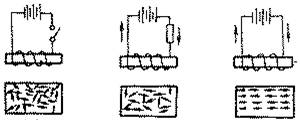I. Introduction The principle of Magnetic Ink stems from the magnetic recording technology, because magnetic printing is a special ink anti-counterfeiting printing technology that adds magnetic substance (iron oxide powder) to the ink for printing, and completes the production of a magnetic recording body. Give it the required special properties. Therefore, magnetic ink can be said to be the protagonist of magnetic printing. This article discusses the principle characteristics, printability and application of magnetic ink. Second, magnetic ink principle and characteristics Since magnetic inks rely on magnetic recording technology, before discussing magnetic inks, it is necessary to understand what magnetism is and how we apply its characteristics to the printing field and become what we know as "magnetic printing." (A) The basic concept of magnetics According to the theory of electromagnetism, we can assume that the magnetic body is composed of a number of very small magnetic domains. Each magnetic domain contains 1012 to 1015 molecules. It has south and north poles and is equivalent to a small permanent. magnet. In general, when the magnetic body is not magnetized, the arrangement of the magnetic domains is disorderly and the magnetic properties of each other cancel each other out. Therefore, the magnetic field is not magnetic, as shown in Fig. 1(a). If a current is applied to the coil outside the magnetic body, the magnetic body is in the magnetic field, and the magnetic field is affected by the magnetizing force, and a tendency tends toward uniform arrangement, as shown in FIG. 1(b). If the magnetism is used to increase the magnetization again, the arrangement of the magnetic domains will become more uniform, and finally the magnetic properties of the magnetic body will reach a maximum value, as shown in Fig. 1(c). In other words, the magnetic lines of force of the magnetic body at this time have reached saturation. When the magnetic field of the outside world disappears, the arrangement of the magnetic domains of the magnetic body remains in a neat state and becomes a permanent magnet. The above is the basic concept of magnetism. (a) Current is zero (b) Small current (c) Large current Figure I. Principle of magnetic domain (B) Magnetic record principle and characteristics The principle of magnetics was used for recording as “magnetic recordingâ€, and the earliest application of magnetic recording technology was exhibited in Paris in 1898. The principle of magnetic recording is as follows: The magnetic recording principle of the security magnetic ink is basically the same as the magnetic recording principle of the audio tape. The magnetic head used for recording is composed of a toroidal core with voids inside and a line diagram wound around the core (as shown in FIG. 2). The magnetic card is made of a film base of a certain material and a granular magnetic material uniformly coated on the film base. The principle of the recording work is that the magnetic surface (or recording head) of the magnetic card moves at a certain speed, respectively. Contact with the gap (or magnetic surface) of the recording head. Once the coil of the magnetic head is turned on, a magnetic field proportional to the current is generated in the gap between the magnetic coils, and the magnetic body in contact with the gap is magnetized to generate magnetic force. Sometimes, the recording signal current will change with time, plus the magnetic card (head) is in a moving state, so when the magnetic body on the magnetic card passes through the gap, it will be magnetized to varying degrees with the change in the magnitude of the current. After the magnetic card is magnetized, the magnetic card magnetic layer that leaves the gap leaves "remanent magnetization" corresponding to the change in current. In the magnetic recording, it must be noted that in order for the magnetic card to move smoothly, the surface of the magnetic head must be shaped so that the magnetic card can smoothly move over the magnetic head and use the pressure to keep the magnetic card and the surface of the magnetic head in contact (Figure 3). In this process, in addition to generating some leakage flux through the gap and passing through the non-ferromagnetic base, most of the magnetic flux passes through the oxide magnetic layer on the magnetic card, and the maximum magnetic flux density is in the space between the two pole shoes. . The characteristics of the magnetic recording body are as follows: 1. The machine used for recording is small and portable; 2. The physical and chemical properties of the materials used for recording are stable; 3. Fixing does not use chemicals when recording; 4. It is stable under normal climatic conditions and it is easy to keep records; 5. Eliminating re-recording, repeated use, quite economical. Due to the above characteristics of magnetic recording media, they are mostly used in security printing, such as magnetic cards, tickets, passbooks, etc., to avoid counterfeiting. Advertising Pen, Customized Logo Pen, Advertising Ink Pens, unique cheap fine pen Tonglu shangmei pen industry co.,ltd , https://www.shangmeipenindustry.com


(to be continued)
Application of Magnetic Ink